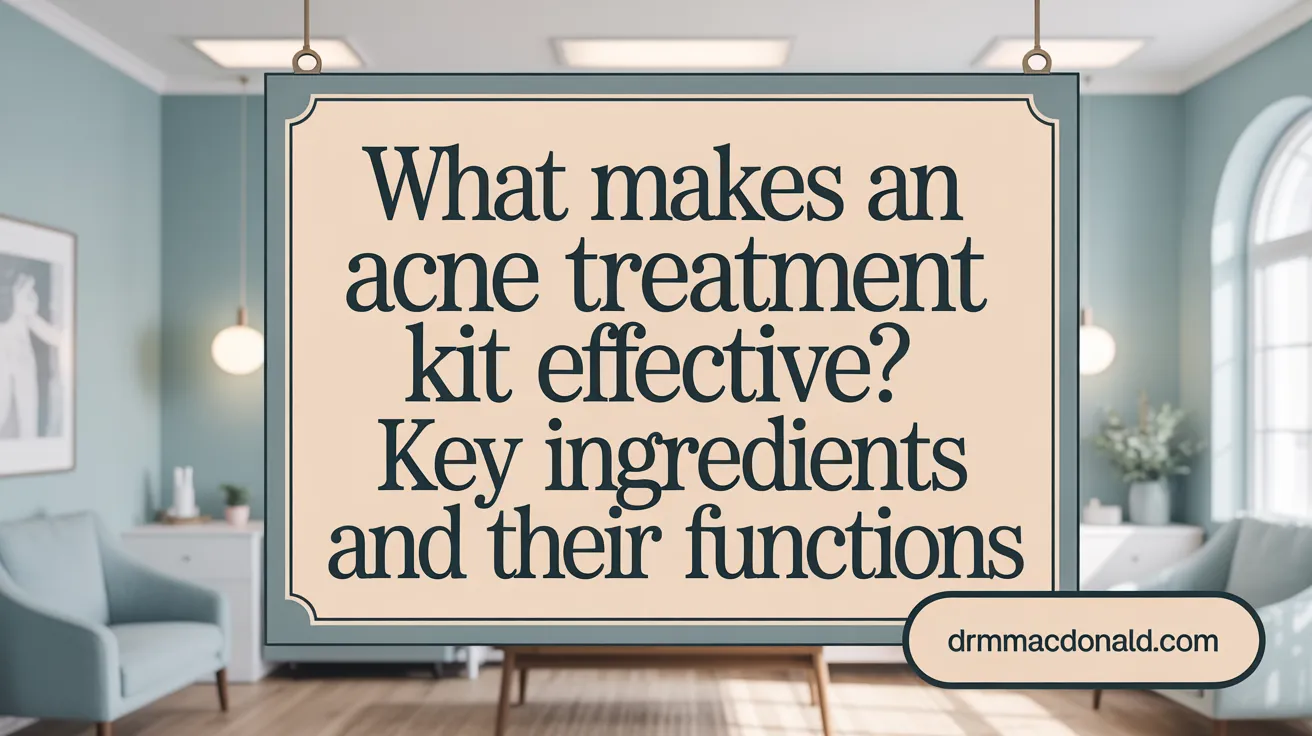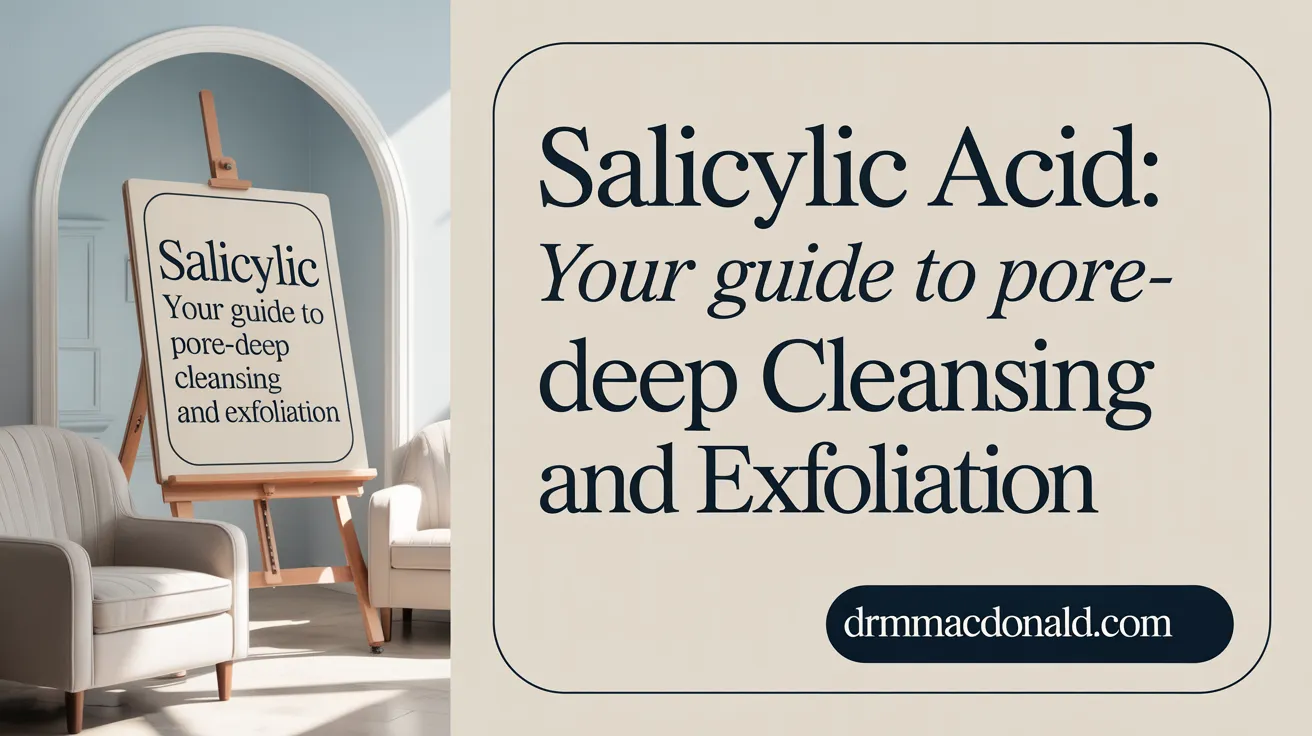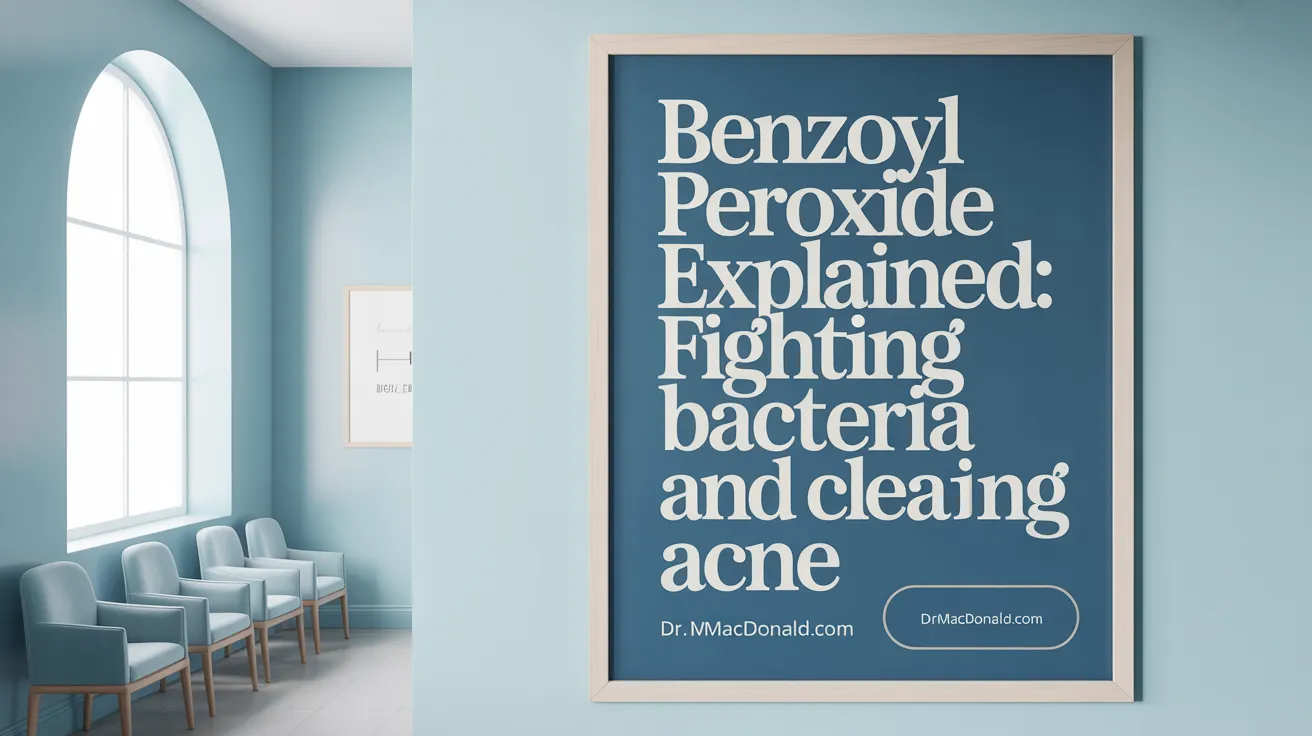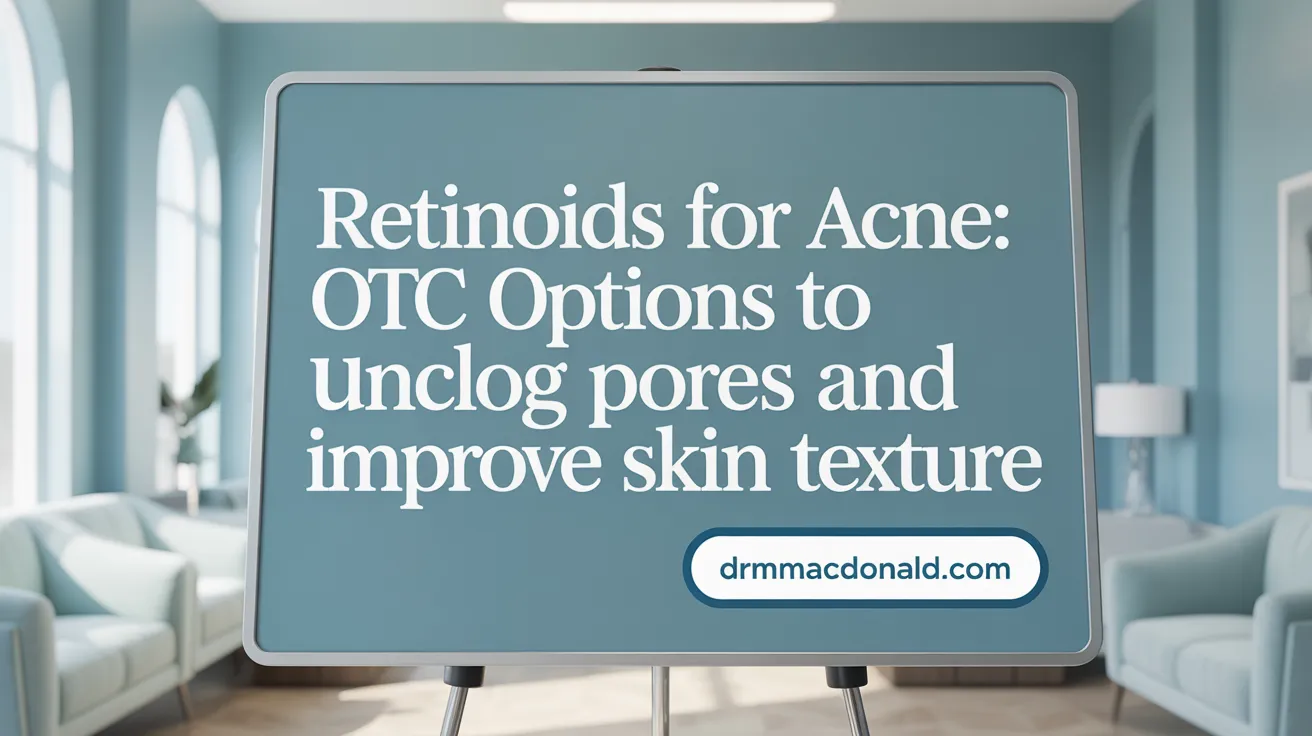Understanding Acne and Treatment Essentials
Acne is a widespread skin condition affecting millions, caused by clogged pores via oil, dead skin cells, and bacteria. Managing acne involves a consistent, targeted skincare regimen using effective ingredients proven to clear, prevent, and soothe blemishes. This article breaks down common acne treatment kits, exploring their ingredients and explaining how each works to improve skin health and clarity.
Key Components of Acne Treatment Kits

Common products in acne kits
Acne treatment kits typically include three essential products: a cleanser, a treatment solution or serum, and a moisturizer. For example, The Acne Set features a Glucoside Foaming Cleanser, a Salicylic Acid 2% Solution serum, and a Natural Moisturizing Factors + Beta Glucan moisturizer. Similarly, other kits like the Proactiv 3-Step Routine contain a cleansing gel, a toner or exfoliant, and a benzoyl peroxide-based treatment.
Functions of cleanser, treatment, and moisturizer in kits
The cleanser works to gently remove dirt, oil, and impurities from the skin’s surface, preparing it for active treatment. In acne-prone skin, cleansers are often formulated to be mild and suitable even for sensitive skin, improving skin clarity and texture over time.
The treatment product, usually a serum or gel, contains active ingredients like salicylic acid or benzoyl peroxide that exfoliate dead skin cells, unclog pores, kill acne-causing bacteria, and reduce inflammation. For example, salicylic acid promotes surface exfoliation and prevents new breakouts by clearing clogged pores.
The moisturizer complements the routine by providing hydration without clogging pores. Formulations often include natural moisturizing factors, ceramides, and soothing agents like beta glucan to strengthen the skin barrier and maintain all-day hydration. This is critical because many acne treatments can dry or irritate the skin.
Formulation considerations for acne-prone skin
Products targeting acne-prone skin focus on maintaining a balance between effective treatment and skin tolerance. Cleansers avoid harsh ingredients to prevent irritation. Treatment actives are formulated in lower concentrations initially (e.g., 2% salicylic acid or 2.5% benzoyl peroxide) to reduce side effects while being effective. Moisturizers are lightweight, non-comedogenic, and contain barrier-supporting ingredients. Additionally, some kits provide detailed usage instructions and safety guidance, including patch testing to ensure compatibility with sensitive skin.
Acne treatment kits aim to offer a comprehensive approach—cleansing, treating, and moisturizing—to support skin health while effectively managing acne.
Salicylic Acid: The Pore-penetrating Exfoliant

What is the role of salicylic acid in acne treatment?
Salicylic acid is a beta hydroxy acid specifically valued in acne care for its ability to penetrate pores deeply. It gently exfoliates the skin by encouraging the shedding of dead skin cells, which helps prevent pores from becoming clogged with excess oil and debris. This action clears existing comedones like blackheads and whiteheads and also helps prevent new breakouts by maintaining open pores. It is effective in treating mild to moderate acne and is found in various cleansing and treatment products. For more information, see Salicylic acid benefits for acne and Salicylic acid for acne-prone skin.
What are the common concentration ranges and product examples?
Salicylic acid products typically contain concentrations ranging from 0.5% to 2%. For instance, The Acne Set includes a Salicylic Acid 2% Solution serum aimed at treating and preventing acne by exfoliation and pore cleansing. Other products like CeraVe's Acne Control Gel also use a 2% concentration, which is a common strength for over-the-counter products that balance efficacy and tolerability. Refer to resources on Over-the-counter acne products and salicylic acid benefits for more product examples.
What are the benefits and potential side effects of salicylic acid?
Benefits of salicylic acid include unclogging pores, reducing the appearance of enlarged pores, and gently exfoliating without overly drying the skin. It is suitable for sensitive or acne-prone skin and can improve skin texture, clarity, and radiance over time. See Effective ingredients for acne-prone skin and Benzoyl peroxide and salicylic acid benefits for more details.
Potential side effects may include mild skin irritation, stinging, discoloration, or dryness, especially when first used or if applied too frequently. Proper patch testing and gradual introduction into skincare routines can minimize these effects. Additionally, because some salicylic acid products increase sun sensitivity, daily sunscreen use is recommended during treatment, as detailed in Skincare tips for acne and sun protection.
Using salicylic acid as part of a consistent skincare regimen, such as alongside moisturizers containing ceramides and beta glucan, supports skin barrier health while effectively managing acne-prone skin. Recommended products include Natural Moisturizing Factors + Beta Glucan and Lightweight gel moisturizers for acne-prone skin.
Benzoyl Peroxide: Targeting Acne-causing Bacteria

How benzoyl peroxide works
Benzoyl peroxide is a widely used over-the-counter acne product ingredient that effectively targets acne-causing bacteria, specifically Cutibacterium acnes (formerly Propionibacterium acnes). It works by releasing oxygen into pores, which kills bacteria thriving in the oxygen-poor environment of clogged pores. This antimicrobial action helps reduce inflammation and clear existing acne lesions. Beyond bacterial control, benzoyl peroxide also promotes the removal of dead skin cells and excess oil, preventing the formation of new pimples (Benzoyl peroxide benefits).
Usage concentrations and effectiveness
Benzoyl peroxide is available in strengths ranging from 2.5% up to 10%. Studies show that lower concentrations can be as effective as higher doses, with the added benefit of causing fewer side effects (Starting acne treatment). Products commonly contain 2.5% or 4% benzoyl peroxide for daily use, which can adequately manage mild to moderate acne. It is important for users to start with lower concentrations to gauge skin tolerance (Benzoyl peroxide acne treatment).
Managing side effects and combining with other ingredients
While effective, benzoyl peroxide can sometimes cause dry skin, redness, irritation, and can bleach hair or clothing. To minimize side effects, it is recommended to start slowly and incorporate moisturizers to maintain the skin barrier (Avoiding acne irritation. Combining benzoyl peroxide with other acne-fighting ingredients like salicylic acid or adapalene requires care, often under dermatologist guidance, to avoid excessive irritation (Proper skin care for acne. Using gentle cleansers and non-comedogenic moisturizers alongside benzoyl peroxide enhances its benefits while protecting skin health (CeraVe acne products with ceramides and niacinamide).
Retinoids in Acne Kits: Adapted for OTC Use

What Role Do Adapalene and Other Retinoids Play in Acne Treatment?
Retinoids, especially adapalene, are a cornerstone in acne management. Adapalene is a topical retinoid available over-the-counter (OTC at 0.1% concentration. It works by speeding up skin cell turnover, which helps to unclog pores and prevents new acne lesions from forming. Apart from clearing existing blemishes, retinoids also improve skin texture and can reduce post-acne marks over time.
How Do Retinoids Benefit Acne-Prone Skin?
Adapalene and similar retinoids prevent the buildup of dead skin cells inside pores, reducing the chances of both inflammatory and non-inflammatory acne. They also have an anti-inflammatory effect, which helps soothe redness and swelling associated with breakouts. Hence, retinoids act on multiple acne-causing factors and are often recommended when standard treatments don't fully control the condition.
What Are the Usage Guidelines and How to Manage Skin Reactions?
When beginning retinoid treatment, it is important to start gradually to allow your skin to adapt. Applying a pea-sized amount once daily, preferably at night, helps minimize irritation. Initial side effects like dryness, redness, stinging, or scaling are common but tend to improve with continued use. Using a gentle cleanser and a non-comedogenic moisturizer can help reduce these effects. Sunscreen is essential during the day due to increased sun sensitivity.
If irritation persists, it's advisable to reduce frequency or consult a healthcare provider. Following these guidelines ensures retinoids can deliver their benefits safely and effectively.
In summary, OTC retinoids like adapalene provide accessible, evidence-based options to unclog pores, prevent acne, and improve skin quality, making them invaluable components of modern acne treatment regimens.
Moisturizers and Supporting Ingredients: Enhancing Skin Health
Why Are Moisturizers Important in Acne Care?
Moisturizers are essential in acne treatment as they help maintain skin hydration without clogging pores. Acne medications like benzoyl peroxide for acne and salicylic acid benefits can dry out the skin, causing irritation and peeling. Using a lightweight gel moisturizer helps soothe the skin and prevents moisture loss, which supports healing and reduces flakiness.
Which Ingredients Support Skin Health in Acne-Prone Skin?
Moisturizers designed for acne-prone skin often include ingredients that promote skin barrier repair and reduce inflammation:
- Ceramides: Lipids that strengthen the skin’s natural barrier and lock in moisture (Ceramides for skin barrier restoration.
- Beta Glucan: A soothing agent with antioxidant properties that helps calm irritated skin and encourages healing (Natural Moisturizing Factors + Beta Glucan).
- Niacinamide: Also known as vitamin B3, it reduces redness, regulates sebum production, and improves skin texture (Niacinamide for skin soothing and hydration.
These ingredients work in synergy to repair damage caused by acne and treatments, while keeping the skin hydrated and less reactive.
How Do Moisturizers Protect and Restore the Skin Barrier?
The skin barrier protects against environmental aggressors and bacteria. Acne treatments can disrupt this barrier, leading to dryness and sensitivity. Moisturizers containing natural moisturizing factors, ceramides, and beta glucan restore this barrier by replenishing essential lipids and delivering hydration. This restoration supports skin resilience, decreases irritation from active acne ingredients, and improves overall skin texture and radiance.
Choosing moisturizers formulated specifically for acne-prone skin, like gel-based products with these key ingredients, effectively balances treatment efficacy with skin comfort and protection.
Additional Active Ingredients: Alpha Hydroxy Acids and Azelaic Acid
What are Alpha Hydroxy Acids (AHAs) and their benefits?
Alpha hydroxy acids, including glycolic and lactic acid, are naturally-derived compounds used in acne treatment. They work by exfoliating the skin's surface, removing dead skin cells, and stimulating the growth of new, smoother skin. This process helps calm inflamed skin and can improve the appearance of scars and pores, making AHAs valuable for skin texture and tone enhancement.
What are the antibacterial and anti-inflammatory effects of Azelaic Acid?
Azelaic acid is a gentle acid with mild antibacterial properties that help prevent the growth of acne-causing bacteria. It also reduces inflammation, which makes it effective for inflammatory acne types. Additionally, azelaic acid can lighten post-inflammatory hyperpigmentation, helping to reduce acne-related dark spots. Learn more about Azelaic acid for acne.
How do AHAs and Azelaic Acid complement core acne treatments?
Both AHAs and azelaic acid enhance acne treatment by targeting underlying issues from different angles. AHAs exfoliate to prevent pore clogging and promote skin renewal, complementing ingredients like salicylic acid that unclog pores. Azelaic acid addresses bacterial growth and inflammation, boosting the effects of antibacterial agents like benzoyl peroxide.
Together, these ingredients provide a comprehensive approach when combined with core acne treatments, improving skin clarity, reducing breakouts, and addressing acne-related discoloration and texture.
Designing an Effective Acne Regimen: Step-by-Step Approach
What are the essential steps in an acne treatment regimen?
An effective acne regimen typically involves four steps: cleansing, exfoliating, treating, and moisturizing. Cleansing removes dirt, oil, and impurities from the skin, preparing it for treatment. Exfoliating helps shed dead skin cells to prevent pores from clogging. Targeted treatment addresses acne-causing bacteria and inflammation, while moisturizing supports skin hydration and barrier health, reducing irritation caused by acne products.
How do products like The Acne Set and Proactiv illustrate this routine?
The Acne Set offers a clear example with its three-step system designed for acne-prone skin:
- Glucoside Foaming Cleanser: A gentle gel cleanser that removes dirt and impurities, improving skin texture and radiance.
- Salicylic Acid 2% Solution: A water-based serum providing gentle exfoliation to clear pores and prevent breakouts.
- Natural Moisturizing Factors + Beta Glucan: A lightweight gel moisturizer that hydrates and strengthens the skin barrier.
Similarly, the Proactiv Solution® 3-Step Routine includes:
- Renewing Cleanser: Contains benzoyl peroxide to kill acne-causing bacteria and cleanse skin.
- Revitalizing Toner: Combines witch hazel and glycolic acid to minimize pores and exfoliate.
- Repairing Treatment: Uses benzoyl peroxide to treat active blemishes and prevent new ones.
Both regimens promote cleansing twice daily, targeted exfoliation and treatment, followed by moisturizing to maintain skin health.
What practices optimize the effectiveness of these regimens?
To maximize benefits from acne treatments, consider the following:
- Start with Patch Testing: Avoid irritation by testing products on a small skin area before full use.
- Use Gentle Products: Choose non-comedogenic, fragrance-free cleansers and moisturizers to avoid aggravating skin.
- Follow Instructions: Adhere to product usage guidelines carefully, avoiding overuse which can cause dryness or redness.
- Consistent Routine: Acne treatments take time; expect improvements in 2-3 months with regular application.
- Sun Protection: Many acne ingredients increase sun sensitivity; use broad-spectrum SPF 30 or higher daily.
- Hydrate and Support Barrier: Regular moisturizing helps protect skin during exfoliation and treatment.
- Avoid Irritants & Picking: Steer clear of harsh scrubs and resist squeezing pimples to reduce inflammation and scarring.
By combining targeted products with a thoughtful routine, those struggling with acne can achieve clearer, healthier skin over time.
Safety and Usage Guidance: Patch Testing and Irritation Avoidance
Why is patch testing important before using acne products?
Patch testing is a crucial step in acne treatment to ensure that the product does not cause an adverse skin reaction. Since many acne treatments contain active ingredients like salicylic acid, benzoyl peroxide, or retinoids, which can potentially irritate the skin, a patch test helps detect sensitivity or allergic responses early. Users should apply a small amount of the product to a discreet skin area and monitor for redness, itching, or swelling before applying it all over the face. For detailed guidance refer to The Acne Set patch testing and usage instructions.
How can common side effects be managed?
Common side effects of acne treatments include dryness, redness, mild stinging, peeling, and irritation. To manage these effects:
- Start with a lower strength product and gradually increase usage to allow skin to adapt, a recommendation highlighted in Mayo Clinic's starting acne treatment tips.
- Use gentle, noncomedogenic moisturizers such as Natural Moisturizing Factors + Beta Glucan or products containing niacinamide to combat dryness and support the skin barrier.
- Avoid overuse or aggressive scrubbing that may worsen irritation, which is emphasized in dermatologist recommendations on acne treatment routines.
- Limit application to once daily initially, then increase frequency as tolerated as suggested by Proactiv Solution usage instructions.
- Use sunscreen daily because many acne treatments increase sun sensitivity; consult CeraVe's advice on sun protection for acne.
What are the recommendations for sensitive skin and when should a dermatologist be consulted?
For sensitive skin, choosing formulations designed to be gentle, such as glucoside foaming cleansers or products with soothing ingredients like niacinamide and beta glucan, can reduce irritation. Introducing one product at a time and avoiding combinations that may overly dry or inflame skin is advisable as noted by Mayo Clinic's acne care tips.
If side effects persist, worsen, or if acne does not improve after 2 to 3 months of consistent use, consulting a healthcare provider or dermatologist is recommended. They can offer tailored treatment plans, prescribe appropriate medications, or identify possible allergies or underlying conditions affecting the skin, as stated in the NHS acne treatment guidelines.
By following these safety and usage guidelines, individuals can optimize the effectiveness of their acne treatments while minimizing potential irritation.
Environmental Considerations: Packaging and Sustainability in Acne Kits
Are recycling instructions included in acne kits?
Many acne treatment kits now include clear recycling instructions on their packaging. For instance, The Acne Set explicitly provides detailed guidelines on how to prepare containers for recycling. Such instructions often cover rinsing containers and separating different components to ensure proper recycling processes. This transparency helps consumers participate actively in reducing environmental impact.
How do brands commit to environmental responsibility?
Leading skincare brands emphasize environmental responsibility by designing sustainable packaging. They promote recycling initiatives and often use recyclable materials to minimize waste. Some brands also highlight their commitment to eco-friendly practices on their websites, encouraging consumers to recycle and reduce their skincare carbon footprint. This fosters trust and aligns brand values with environmental sustainability.
Why is consumer awareness on eco-friendly packaging important?
Consumer awareness plays a crucial role in driving demand for sustainable products. When acne kit users are informed about eco-friendly packaging and recycling options, they are more likely to support brands prioritizing sustainability. Increased awareness helps reduce landfill waste and promotes a circular economy. By choosing products with transparent recycling practices, consumers contribute to a healthier planet while managing their skin health.
In summary, including recyclable packaging along with clear packaging recycling information and promoting environmental responsibility are becoming standard practices in acne kit manufacturing. These efforts empower consumers to make sustainable choices in their daily skincare routine.
Patient Experiences and Results: What Users Can Expect
Typical Timelines for Visible Improvements
Most acne treatments, especially over-the-counter kits, require patience as visible results typically take 2 to 3 months of consistent use. Some products may show improvements within the first couple of weeks, but full benefits generally appear after several weeks to a few months. For example, clinical studies show that comprehensive acne systems often demonstrate clearer skin after 12 weeks, with some users noticing changes as early as 7 days with certain products (Clear Proof® Acne System, Mayo Clinic Acne Treatments.
Variability in Skin Response and Importance of Patience
Individual skin responses to acne treatments can vary significantly. Factors such as skin sensitivity, the severity of acne, and the type of active ingredients influence how quickly and effectively a regimen works. Initial skin irritation or dryness may occur, and in some cases, acne can temporarily worsen before improving. This underscores the importance of adhering to a regimen and using products as directed, including patch testing and gradual introduction of actives to minimize side effects (The Acne Set, Mayo Clinic Acne Treatments.
Customer Testimonials and Dermatological Study Findings
Customer feedback often highlights effectiveness, ease of use, and skin improvement with targeted acne regimens. Testimonials from teens and adults report reductions in pimples, blackheads, and overall skin clarity with consistent treatment (The Acne Set, Proactiv Solution 3-step routine. Dermatological studies reinforce these findings, confirming significant reductions in acne lesions and improvements in skin texture and radiance over time (Clear Proof® Acne System, Mayo Clinic Acne Treatments. Transparency from brands, including posting both positive and critical reviews, allows prospective users to make informed decisions based on varied experiences (The Acne Set.
Bringing It All Together: The Science Behind Your Acne Kit
Acne treatment kits combine scientifically supported ingredients like salicylic acid, benzoyl peroxide, retinoids, and supportive moisturizers to disrupt acne formation and promote clearer skin. Using these products as directed—incorporating cleansing, exfoliating, treating, and moisturizing steps—can effectively manage breakouts while maintaining skin health. With proper safety practices, patience, and sustained use, acne kits offer a practical solution for many suffering from acne-prone skin. Additionally, attention to packaging sustainability and transparent product information further enhances consumer confidence and satisfaction in their skincare journey.
